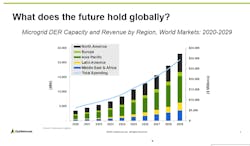The microgrid industry is bullish about the future of the microgrid market over the next 10 years, expecting the energy as a service model and modular microgrids to grow quickly worldwide. But in the US, regulatory challenges create hurdles, said speakers Tuesday during the second day of the Microgrid 2020 Global Conference.
“If we lay the groundwork over the next few years and we do the work, I really do think…we’re going to have a really transformational decade in the US and then the sky’s the limit from there,” said Tim Hade, co-founder and COO of Scale Microgrid Solutions, during a panel, “How Far and How Fast Can Microgrids Grow Over the Next Decade.”
Peter Asmus, research director for Guidehouse, provided a snapshot of what’s hot right now in worldwide markets and what’s growing. The energy as a service model makes up 44% of the market share around the world by project number count. Owner financing is the second most popular model, based on project numbers, followed by government projects, then utility rate basing.
Based on project capacity, owner financing holds the lead at 36% of the global market share, followed by energy as a service at 19% of market share. Utility rate based projects are third.
“Energy as a service will be the fastest growing business model,” said Asmus.
Microgrid users don’t need to put any capital down under the energy as a service model, which is a major benefit for businesses and institutions.
Along with energy as a service contracts, modular microgrids are hot and expected to continue to grow.
“So I think, like in California where the idea is you want lots of microgrids, actually smaller scale systems to be employed quickly, modular is the way to go,” Asmus said.
Modular microgrids will make up about a quarter of the market by 2029, he added. That’s worth $5 billion annually.
Remote microgrids are also expected to be winners. The remote segment, which began in Australia and Alaska and other remote regions where off-grid microgrids are a focus, makes up 44% of the market, based on data collected over the last 20 years or so. Commercial and industrial microgrids, which used to be the smallest share, now place second, at 26%. That’s due, in part, to the fact that businesses — especially those in California that have suffered through numerous Public Safety Power Shutoffs (PSPS) in recent years — are seeing the value of resiliency.
And utility projects, which tend to be larger in size, come in third.
Looking ahead 10 years, the Asia Pacific region is expected to be the largest world market, with a focus on remote microgrids. Europe is the smallest because the grid is so reliable and there’s a big focus on Virtual Power Plants.
“Most in Europe are on remote island not connected to the grid,” Asmus said.
Latin America is a growing market. “We’re big on the Carribean and Puerto Rico; there have been some positive developments there,” said Asmus.
Join the more than 4,300 participants this week at Microgrid 2020 Global. Learn, network, connect and help shape the future of this fast-growing industry.
While the COVID-19 pandemic slowed installations in 2020, it’s expected to have an overall positive impact on the industry.
“In terms of COVID-19, I think actually, in the long run, COVID-19 helps the microgrid market in general because it’s just another emergency, and people focused on resiliency from extreme weather events, wildfires, terrorists, threats and then the pandemic. So it doesn’t solve the pandemic, but it does contribute to this idea of preparation for unexpected events,” he said.
Asim Hussain, Bloom Energy
Asim Hussain, vice president of commercial strategy and customer experience at Bloom Energy, said that the primary driver in the microgrid industry is the need for a reliable grid system, given the challenges of both an aging infrastructure and climate change.
He predicts that by 2030, microgrids will be dispersed in the main grid in a way that creates a hybrid centralized infrastructure.
“There’s a point at which the microgrids are being done right now behind the meter, but then the evolution is going to be such that there’s going to be microgrids both behind the meter and utilities are going to look to adopt microgrids in front of the meter, more deeper into their distribution, maybe closer to substations, for example, and end users,” he said.
It’s important that regulations change to make way for more movement in the microgrid industry, Hussain said.
“Can we have the right rules in place and have them be simple enough so customers are not penalized?,” he asked. Right now, microgrid operators are sometimes penalized if they remove load from the grid. This is a “huge challenge” that needs to be addressed.
To meet the need for power 24/7, Bloom combines fuel cells with other technologies such as solar and storage. However, the company has to deal with different sets of regulations for each technology.
Scale Microgrid Solutions’ Hade also sees regulatory issues as big hurdles. But the economics of microgrids are improving because of lower distributed energy resources (DER) costs and increasing compensation for ancillary services from microgrids, he said. The need for resiliency in response to hurricanes, wildfires and other disasters is also moving the market.
The industry is not experiencing much regulatory progress, said Hade.
One example is California, which in 2018 passed SB 1339, with the intent to get more microgrids installed. Nothing meaningful has resulted from that legislation, he said.
Tim Hade, Scale Microgrid
The New York Reforming the Energy Vision (REV) hasn’t yielded the results Hade expected either. He thought it was going to be a “big deal,” he said.
One positive regulatory effort is California’s self generation incentive program (SGIP), said Hade.
Rather than trying to incentivize an outcome, it provides incentives for pieces of technology that will allow entrepreneurs and the business community to implement ideas and learn.
Thanks to the SGIP, many batteries are being deployed in a way that will help provide resilience during PSPS, making a big difference for commercial and industrial customers.
Ultimately, microgrids will make a big difference for all customer segments and the grid, the speakers said.
“I’m very, very bullish and optimistic about microgrids,” said Hussain.








